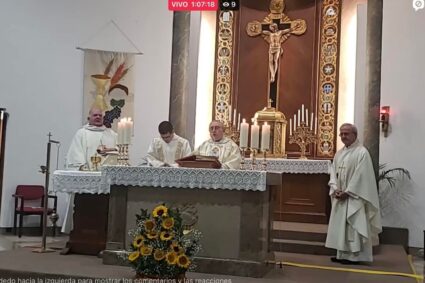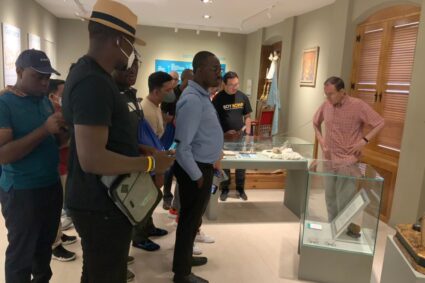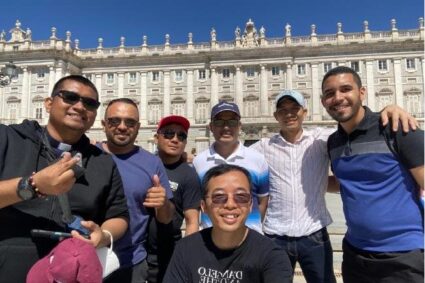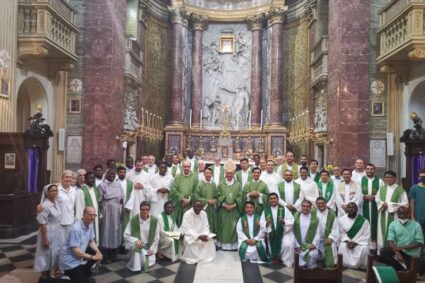
English / Castellano
Thus begins the third chapter of our Constitutions, dedicated to Piarist community life. And so begins the second “key of life” of our 48th General Chapter, which proposes “to revitalize our community life and to take special care of the central aspects emphasized by our Constitutions“.
I would like to dedicate next few ‘salutatio’ to share with all of you some aspects of our General Chapter that I consider particularly significant, in this way contributing to the process of welcoming the Chapter in which we are all involved. I will try to do it from a very concrete point of view: what are the points of attention that our Chapter proposes to us in each of the areas of our life and mission. Let us begin with community.
I will try to organize my reflection from three complementary points of view: some transversal processes proposed by the Chapter, some concrete options for renewal and, among them, some that may be particularly new and demanding. Let’s move on.
I-The transversal dynamics are very valuable. They can illuminate all areas of our life and offer suggestions for renewal in all of them. I have chosen four, which the General Chapter underlines in a special way around Community Life, but which, by their own transversal nature, affect and energize each and every one of the Keys of Life of the Pious Schools. There are certainly a few more, but we will leave them for another time.
a. First, I would like to turn to the theme of processes, itineraries and learning paths, which our Chapter calls “learning to learn”. I think this is a very significant wake-up call for us educators. We know that the development of people, the configuration of options, transformations and changes do not happen overnight. Time is needed, but “active” time, time that is cared for and full of meaning, a time that becomes a process, an itinerary and a dynamic of learning.
Our General Chapter invites us to “choose to learn to live in community“, through formative processes and itineraries that help us to do so. It also invites us to “unlearn“, because there may be dynamics among us that do not help and that are consolidated. It is good that we can identify and redefine them.
b. Secondly, I would like to refer to the Constitutions. Our “fundamental text” is quoted in each and every one of our Keys of Life, and that is something very significant for us. When we speak of Community Life, what the Chapter says is “to renew our community life and to take special care of the central aspects underlined by our Constitutions”. Possibly we are facing a permanent task, which we must know how to carry out in a new way. What do the Constitutions ask of us, today in a special way, before the challenge of the renewal of our community life?
Just by way of example, I would like to take note of number 28, which says that “we wholeheartedly accept others as they are, and actively help them to mature in their abilities and to grow in love“. It is interesting to read this proposal today, from the point of view of our intercultural, intergenerational and even inter-vocational communities[1] . There is much work ahead of us.
c. I would like to point out a third consideration, related to two learning experiences that were especially highlighted during the Chapter: accompaniment and community discernment. Our Chapter challenges us in two particularly significant areas, in which I believe we have much to learn and reflect on. One is the capacity of our communities to accompany the life and vocation process of religious, and the desire and openness of religious to be truly accompanied. Both are a challenge, because both require transparency, a desire to share, dedication of time and community dynamics that make this possible. I believe that more than one personal problem would have been solved well – and in time – if this chapter proposal were lived in a more real and frequent way among us.
Community discernment is, without a doubt, one of the most fundamental elements that we have to face. I will try to dedicate some fraternal letter to this topic. For now, it is enough to highlight the challenge, as the Chapter did, and to do it in the terms in which we have to do it: we have to learn.
In this Easter season we read the Acts of the Apostles. In those first moments of the Church, community discernment in the light of the Spirit, in order to seek God’s will, was what helped them to seek new answers to new situations and to overcome old ties that did not make sense in the light of the source experience of the Lord’s Passover. We also find ourselves in a new situation, and we need processes of discernment to find the best options. Our General Chapter insistently proposes this to us.
d. The fourth transversal key that I would like to highlight has a very concrete name: the Eucharist. A General Chapter that insistently proposes that there is only one center (Christ the Lord) and that clearly reminds us that the privileged space for living and sharing this center is the Eucharist, could not fail to inspire us with ways to live it with increasing authenticity. It is enough for me to recall this chapter affirmation: “The celebration of the Eucharist is for us an itinerary of life, incorporating into our lifestyle what we ritually celebrate: acceptance, forgiveness, listening to the Word, offering of our gifts, life given, thanksgiving and sending on mission[2] “.
II-The General Chapter proposes some very concrete and demanding “options for the renewal of our Community Life”. I am going to highlight some of them, all of them taken from the General Lines of Action approved by the Chapter Assembly. I do not seek to elaborate on them; I only wish to help us to approach them. I quote four of them[3] .
- There are some options that are considered by the Chapter as “especially urgent“. They are the following: open and welcoming communities; communities that are “schools of prayer”; communities that bet on the construction of a new Piarist subject formed by religious and laity; communities that care for and accompany the vocation process of each Piarist, religious or lay. It is interesting that it is said of these four options that they are “urgent”. The four are expressed with a nuance of activity, of process, of change: to be school, to welcome, to build, to accompany, to take care… It is very suggestive to read these proposals in the context of each of our communities, as an institutional call – for that is what they are – to our conversion.
- The acceptance in our communities of the ecclesial call to synodality is expressed above all in two moments especially emphasized by the Chapter: the Eucharist and the community meeting. This is very clear, Brothers.
- The role of the local superior and his service of pastoral leadership clearly emerges. I think that in this sexennium we should advance in this topic, based on simple but effective proposals of formation, and on dynamics that make it possible.
- It would be very helpful if we could make progress in the dynamics of projects (personal project, community project and project of presence). Let us be clear that, if we know how to work in this matter, and if we know how to combine well these three realities, we will obtain good fruits. But let us not lose sight of the fact that the Chapter proposes us to live on the basis of the three and to advance in the three. They are different, but complementary. Step by step.
III-There are some quite new proposals, which may even surprise us. It is good to welcome them in this perspective. Perhaps some of them can be one of those “surprises of the Spirit”. I will focus on four:
- That the Piarist communities be responsible for the Pastoral Care for Vocations[4] . We have insisted these years that in each Province there should be a person responsible for the Pastoral Care for Vocations, and also that all religious should feel responsible for the Pastoral Care for Vocations. But perhaps this proposal has escaped us: that the communities be – and feel – responsible for the Pastoral Care for Vocations. I think that we are facing an interesting and very demaning challenge, and that it can help a lot in the dynamics of our communities. And in many areas: community prayer, evangelical witness, welcome, interest, inclusion of the theme in the community project, formation, support for the person in charge, etc.
- That the communities be “schools of community life“. This is expressly said of the houses of formation[5] , but I believe that we should apply it to all communities, because otherwise we run the risk that what is learned in the houses of formation – if they really are schools of community life – will be forgotten over the years, for lack of practice, reinforcement or coherence.
- The “Piarist Christian community“. It appears in almost all the “Keys of Life” approved by the General Chapter. There is no doubt that we are facing a reality that has not only come to stay (Rule 103), but to grow and renew our life and mission. Among other things, the Piarist Christian communities help to situate the religious community in the whole of the Piarist presence, which is one of the greatest needs we have.
- “Communities of communion“. No doubt they already exist among us, but the Chapter has given them a name. In addition to what we live in the religious community of which we are a part, the Chapter recognizes that we religious need to be able to meet at other levels, “with brothers with whom they can share their life and vocation in new and creative ways[6]“.
I end with an invitation. Community is our way of life, the natural space in and out of which we live, grow, work and pray. It is perhaps one of the testimonies that the young people of today need and seek the most. And it is also one of our nostalgia, and we express it frequently in our chapters and assemblies. Perhaps the time has come to take steps, as humble as convinced, as simple as accurate, to move closer to the ideal we seek. And the path is undoubtedly through choices, commitments and risks. Let us live it with joy.
Receive a fraternal embrace.
Fr. Pedro Aguado Sch.
Father General
[1] 48GC. “Under the guidance of the Holy Spirit. Configurating core “In the footsteps of Jesus”, n. 5.
[2] 48GC. “Under the guidance of the Holy Spirit”. Configurating core “In the footsteps of Jesus”, n.11.
[3] 48GC. “Under the guidance of the Holy Spirit.” Key of Life on Community Life. Lines of Action.
[4] 48GC. “Under the guidance of the Holy Spirit”. 7th Key of Life: “Vocation Ministry”, 2nd thesis.
[5] 48GC. “Under the guidance of the Holy Spirit. 8th Key of Life: “Initial Formation”, 5th Line of Action.
[6] 48GC. “Under the guidance of the Holy Spirit”. 2nd Key of Life: Community Life. Line of Action n.7
Reunidos en comunidad de fe
English / Castellano
Así empieza el capítulo tercero de nuestras Constituciones, dedicado a la vida comunitaria escolapia. Y así empieza la segunda “clave de vida” de nuestro 48º Capítulo General, que propone “revitalizar nuestra vida comunitaria y cuidar de modo especial los aspectos centrales subrayados por nuestras Constituciones”.
Quisiera dedicar las próximas salutatios a compartir con todos vosotros algunos aspectos que considero especialmente significativos de nuestro Capítulo General, deseando de esta manera contribuir al proceso de acogida capitular en el que todos estamos metidos. Trataré de hacerlo desde una óptica muy concreta: cuáles son los puntos de atención que nuestro Capítulo nos propone en cada una de las áreas de nuestra vida y misión. Empecemos por la comunidad.
Trataré de organizar mi reflexión desde tres ópticas complementarias: algunos procesos transversales propuestos por el Capítulo, algunas opciones concretas de renovación y, entre ellas, algunas que pueden ser especialmente novedosas y exigentes. Vamos allá.
I-Las dinámicas transversales son muy valiosas. Son capaces de iluminar todas las áreas de nuestra vida, y ofrecen sugerencias de renovación en todas ellas. He elegido cuatro, que el Capítulo General subraya de modo especial en el ámbito de la Vida Comunitaria, pero que, por su propia naturaleza transversal, afectan y dinamizan todas y cada una de las Claves de Vida de las Escuelas Pías. Ciertamente hay unas cuantas más, pero las dejaremos para otro momento.
a. En primer lugar, quiero referirme al tema de los procesos, los itinerarios y los caminos de aprendizaje, que nuestro Capítulo denomina “aprender a aprender”. Pienso que estamos ante una llamada de atención muy significativa para nosotros, educadores. Sabemos que el desarrollo de las personas, la configuración de las opciones, las transformaciones y cambios, no ocurren de la noche a la mañana. Hace falta tiempo, pero tiempo “activo”, tiempo cuidado y pleno de sentido, un tiempo convertido en proceso, en itinerario y en dinámica de aprendizaje.
Nuestro Capítulo General nos invita a “optar por aprender a vivir en comunidad”, a través de procesos e itinerarios formativos que nos ayuden a ello. Incluso nos invita también a “desaprender”, porque puede haber entre nosotros dinámicas que no ayudan y que están consolidadas, y es bueno que las podamos identificar y redefinir.
b. En segundo lugar, me quiero referir a las Constituciones. Nuestro “texto fundamental” es citado en todas y cada una de nuestras Claves de Vida, y eso es algo muy significativo para nosotros. Cuando hablamos de la Vida Comunitaria, lo que dice el Capítulo es “renovar nuestra vida comunitaria y cuidar de modo especial los aspectos centrales subrayados por nuestras Constituciones”. Posiblemente estemos ante una tarea permanente, que debemos saber llevar delante de modo nuevo. ¿Qué nos piden las Constituciones, hoy de modo especial, ante el desafío de la renovación de nuestra vida comunitaria?
Sólo a título de ejemplo, me quiero fijar en el número 28, que dice que “aceptamos de corazón a los demás tal y como son, y les ayudamos activamente a madurar en sus aptitudes y a crecer en el amor”. Es interesante leer esta propuesta hoy, desde la óptica de nuestras comunidades interculturales, intergeneracionales e incluso intervocacionales[1]. Hay mucha tarea por delante.
c. Apunto una tercera consideración, relacionada con dos aprendizajes especialmente resaltados en el Capítulo: el acompañamiento y el discernimiento comunitario. Nuestro Capítulo nos desafía en dos áreas especialmente significativas, en las que creo que tenemos mucho que aprender y que reflexionar. Una es la capacidad que tienen nuestras comunidades de acompañar la vida y el proceso vocacional de los religiosos, y el deseo y apertura de los religiosos a ser realmente acompañados. Las dos cosas son un reto, porque ambas requieren transparencia, deseo de compartir, dedicación de tiempo y dinámicas comunitarias que lo posibiliten. Tengo para mí que más de un problema personal se hubiera resuelto bien -y a tiempo- si esta propuesta capitular fuera vivida de manera más real y frecuente entre nosotros.
El discernimiento comunitario es, sin duda, uno de los elementos más de fondo que tenemos que afrontar. Trataré de dedicar alguna carta fraterna a este tema. Por ahora, basta con resaltar el reto, como hizo el Capítulo, y hacerlo en los términos en los que lo tenemos que hacer: hemos de aprender.
En este tiempo de Pascua leemos los Hechos de los Apóstoles. En esos primeros momentos de la Iglesia, el discernimiento comunitario a la luz del Espíritu, para buscar el querer de Dios, fue lo que les ayudó a buscar respuestas nuevas ante las nuevas situaciones y a superar ataduras antiguas que no tenían sentido desde la experiencia fontal de la Pascua del Señor. Nosotros también nos encontramos en una situación nueva, y necesitamos procesos de discernimiento para encontrar las mejores opciones. Nuestro Capítulo General nos lo propone con insistencia.
d. La cuarta clave transversal que quiero destacar tiene un nombre muy concreto: la Eucaristía. Un Capítulo General que propone insistentemente que no hay más que un centro (Cristo el Señor) y que nos recuerda con claridad que el espacio privilegiado para vivir y compartir ese centro es la Eucaristía, no podía dejar de inspirarnos caminos para vivirlo con creciente autenticidad. Me basta con recordar esta afirmación capitular: “La celebración de la Eucaristía es para nosotros un itinerario de vida, incorporando en nuestro estilo de vida lo que celebramos ritualmente: acogida, perdón, escucha de la Palabra, ofrenda de nuestros dones, vida entregada, acción de gracias y envío en misión[2]”.
II-El Capítulo General propone algunas “opciones de renovación de nuestra Vida Comunitaria” bien concretas y exigentes. Voy a destacar algunas, tomadas todas ellas de las Líneas Generales de Acción aprobadas por la asamblea capitular. No busco desarrollarlas, sólo deseo ayudar a que nos acerquemos a ellas. Cito cuatro de ellas[3].
- Hay algunas opciones que son consideradas por el Capítulo como “especialmente urgentes”. Son las siguientes: comunidades abiertas y con capacidad de acogida; comunidades que sean “escuelas de oración”; comunidades que apuestan por la construcción de un nuevo sujeto escolapio formado por religiosos y laicos; comunidades que cuidan y acompañan el proceso vocacional de cada escolapio, religioso o laico. Es interesante que se diga de estas cuatro opciones que son “urgentes”. Las cuatro están expresadas con un matiz de actividad, de proceso, de cambio: ser escuela, acoger, construir, acompañar, cuidar… Es muy sugerente leer estas propuestas desde cada una de nuestras comunidades, como una llamada institucional -es lo que son- a nuestra conversión.
- La acogida en nuestras comunidades de la llamada eclesial a la sinodalidad se expresa sobre todo en dos momentos especialmente subrayados por el Capítulo: la Eucaristía y la reunión de comunidad. Está muy claro, hermanos.
- Emerge con claridad el rol del superior local y su servicio de liderazgo pastoral. Pienso que en este sexenio debemos avanzar en este tema, desde propuesta sencillas, pero eficaces, de formación, y desde dinámicas que la posibiliten.
- Ayudaría mucho que avanzásemos en la dinámica de proyectos (personal, comunitario y de presencia). Tengamos claro que, si sabemos trabajar en este asunto, y si sabemos combinar bien estas tres realidades, obtendremos buenos frutos. Pero no perdamos de vista que el Capítulo nos propone vivir desde los tres y avanzar en los tres. Son diferentes, pero complementarios. Poco a poco.
III-Hay algunas propuestas bastante nuevas, que pueden incluso sorprendernos. Es bueno acogerlas desde esta perspectiva. Tal vez alguna de ellas pueda ser una de esas “sorpresas del Espíritu”. Me centraré en cuatro.
- Que las comunidades escolapias sean responsables de la Pastoral Vocacional[4]. Hemos insistido estos años en que en cada Provincia haya un responsable de Pastoral Vocacional, y también en que todos los religiosos deben sentirse responsables de la Pastoral Vocacional. Pero tal vez se nos ha escapado esta propuesta: que las comunidades sean -y se sientan- responsables de la Pastoral Vocacional. Pienso que estamos delante de un reto interesante y muy desafiante, y que puede ayudar mucho en la dinámica de nuestras comunidades. Y en muchas áreas: oración comunitaria, testimonio evangélico, acogida, interés, inclusión del tema en el proyecto comunitario, formación, apoyo al responsable, etc.
- Que las comunidades sean “escuelas de vida comunitaria”. Esto se dice expresamente de las casas de formación[5], pero creo que lo debemos aplicar a todas las comunidades, porque de otro modo corremos un riesgo: que lo que se aprende en las casas de formación -si realmente son escuelas de vida comunitaria- se olvide con los años, por falta de práctica, de refuerzo o de coherencia.
- La “comunidad cristiana escolapia”. Aparece en casi todas las “Claves de Vida” aprobadas por el Capítulo General. No hay duda de que estamos ante una realidad que no sólo ha venido para quedarse (Reglas 103), sino para crecer y renovar nuestra vida y misión. Entre otras cosas, las comunidades cristianas escolapias ayudan a situar la comunidad religiosa en el conjunto de la presencia escolapia, siendo ésta una de las necesidades mayores que tenemos.
- Las “comunidades de comunión”. Sin duda ya existen entre nosotros, pero el Capítulo les ha dado nombre. Además de lo que vivimos en la comunidad religiosa de la que formamos parte, el Capítulo reconoce que los religiosos necesitamos poder reunirnos a otros niveles, “con hermanos con los que pueden compartir su vida y vocación de modos nuevos y creativos[6]”.
Termino con una invitación. La comunidad es nuestra forma de vida, el espacio natural desde el que vivimos, crecemos, trabajamos y oramos. Es quizá uno de los testimonios que más necesitan y buscan los jóvenes de hoy. Y es también una de nuestras nostalgias, y así lo expresamos frecuentemente en nuestros capítulos y asambleas. Tal vez ha llegado el momento de dar pasos, tan humildes como convencidos, tan sencillos como certeros, para ir acercándonos al ideal que buscamos. Y el camino es, sin duda, a través de opciones, apuestas y riesgos. Vivámoslo con alegría.
Recibid un abrazo fraterno.
P. Pedro Aguado Sch. P.
Padre General
[1] 48CG. “Bajo la guía del Espíritu Santo”. Núcleo configurador “Al paso de Jesús”, n. 5.
[2] 48CG. “Bajo la guía del Espíritu Santo”. Núcleo configurador “Al paso de Jesús”, n.11.
[3] 48CG. “Bajo la guía del Espíritu Santo”. Clave de Vida sobre la Vida Comunitaria. Líneas de Acción.
[4] 48CG. “Bajo la guía del Espíritu Santo”. 7ª Clave de Vida: “Pastoral Vocacional”, 2ª tesis.
[5] 48CG. “Bajo la guía del Espíritu Santo”. 8ª Clave de Vida: “Formación Inicial”, 5ª Línea de Acción.
[6] 48CG. “Bajo la guía del Espíritu Santo”. 2ª Clave de Vida: Vida Comunitaria. Línea de Acción n.7






